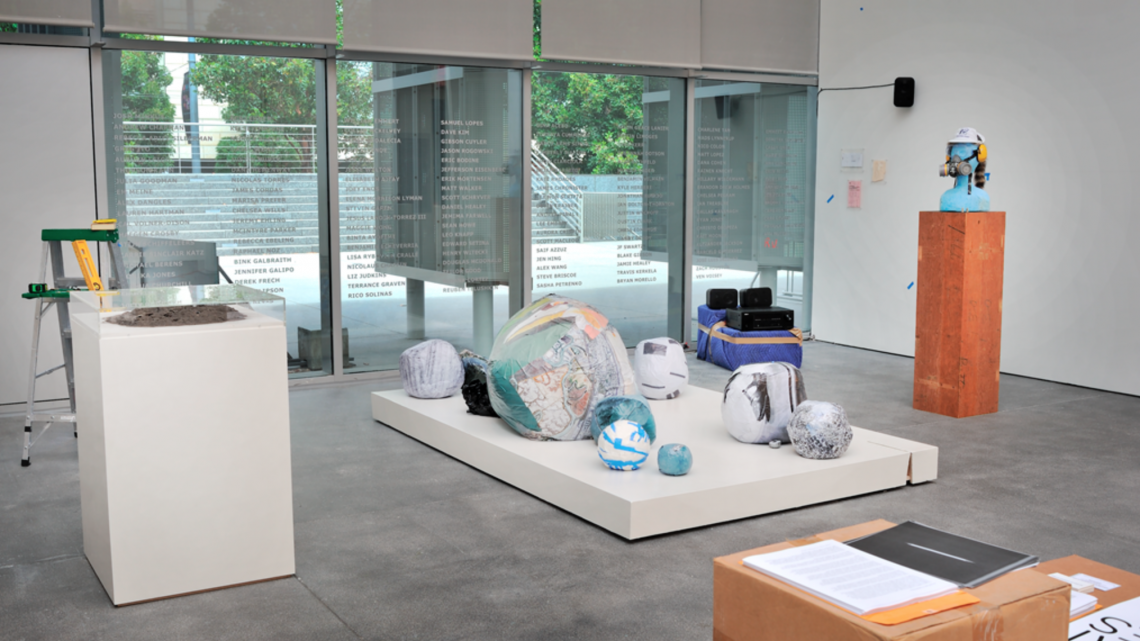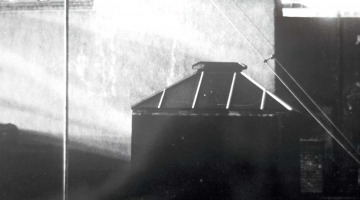BAN7 opened in mid-July, and was immediately panned by some local critics as a watered down massive group show lacking criticality and focus. Before the show opened I interviewed the YBCA Visual Arts curators Bettie-Sue Hertz and Ceci Moss (SFAQ print edition 17, pages 111-113). I was particularly interested in the “decentered” curatorial approach this year. Much to the chagrin of previous exhibited artists who had been “specially chosen” to represent what is current in the Bay Area, this show took that traditional curatorial model and basically threw it aside for a more egalitarian open-call platform. The result is one that opened the doors for 15 independent curatorial entities within the greater Bay Area region to curate their own space within the larger institution.
Here, “something from everybody” could very well be an asset, not the institution’s demise. It is obvious to me that this model opens up terrain that demystifies the notion of the museum as distinctive, and instead situates the institution amongst the other venues, outlets, and spaces that define the Bay Area as a whole as diverse and inclusive. Rather than the institution showcasing a small (usually seven) group of individual artists whom it feels are worthy of notice in the Bay Area now, as the title clearly insinuates, a large public audience is now exposed to many voices and ideas. The exhibiting entities range from galleries, to artists residencies, to public mural painters, to spaces that serve under-recognized artists with disabilities and those who are in prison, to tiny publishing presses, and those who work behind the scenes. I have made a few poignant choices that open dialog about those who are not commonly acknowledged in major metropolitan museums—their challenges and their ability to skirt the adages of the “chosen few.”
The most banal and basic service of a museum is to “house” something, meaning to hold something in secure confines for a period of time. A line from one of the pieces in the show serves my overall case in point: “Houses live and die: there is a time for building and a time for living and for generation.” The line is pulled from T.S. Eliot’s poem East Coker and is one of many pieces in the room occupied by the Bay Area Art Workers Alliance (BAAWA). The poem is made of white vinyl lettering that is adhered to and blends in with the white wall. Virtually invisible, I almost missed it. It is simultaneously there yet barely present, like the unknown traces that preparators and art handlers leave after they install artworks in a space. To me, this piece most precisely visually explains the BAAWA mission of supporting the invisible workers that labor behind the scenes to make exhibitions possible.
BAAWA’s project for BAN 7 is titled, Invisible Labor (Aestheticizing Labor), BAAWA’s installation is one of the most industrious, and features a variety of mixed media sculpture, conceptual text, and ephemeral text-based handouts. On the glass that faces the atrium in the center of the building are the names of 100 artists who are members of BAAWA and who collectively take authorship of the work in the room. Acknowledging the community of workers (who for the most part are also artists themselves) BAAWA turns the seams of the institution inside out so that viewers can begin to acknowledge both the professionalism and the distinct creativity that is hidden within each exhibition.
Each object, statement, or vignette in the room is carefully tailored with conceptual rigor, be it in fabrication or in concept. The room is has many delicately rendered things while a certain amount of clumsiness or even neglect calls attention to the labor involved. For example, a subtle and precise tiny white raised painted line approximately 1/8th inch thick surrounds the 15′ x 20′ room. For those who are familiar, this means that the line was made by adhering two identical, perfectly spaced continuous lines of blue painters’ tape before painting, which is then removed. Subtle, yet hightly labor intensive, the line is emblematic of the detail and sometimes ridiculously absurd requests that preparators must endure to execute someone else’s vision.
In another area a gaping, raw, and mangled hole in the drywall is surrounded by an overabundance of golden picture hanging hooks. Extending from them are simple lines of string adorned with delicate tags carefully scripted with dates. At the end of the strings and situated on the floor are a variety of iconic handtools encased in white plaster. The piece has a regal quality, simulating an elaborate site-specific sculpture, but the materials clearly make art in the museum context a parody.
The sound of saws ripping and tearing through lumber and other heavy industrial noises emanate from a crude yet completely functional boom box with speakers. Blanketing the whole space in an industrial tone resonating labor, the sounds insinuate the activity that takes place on a regular basis before and after an exhibition. They are sounds that are never heard during the duration of a show, especially in museums, which are traditionally very quiet. Here, the noise is disruptive, yet refreshing. In keeping with the constant motion and ever-changing activity of the preparator’s job, the installation will be changed the first week of September and feature different work than what I have just discussed, by different collective artists from the group.
Another space in BAN7 that calls upon concepts of labor is the installation by Publication Studio. The space features enlarged pages from some of their published offerings, as well as books, including Joel Dean’s Superdome and Oki Sogumi’s The Island of Natural History. Also on display are enlarged prints from Kevin Killian’s project Tagged: Variations on a Theme—a photo project of nude men holding a drawing of a phallus by Raymond Pettibon. On the back wall is a custom uniform which serves as a conceptual object to represent “the worker.” Designed with multiple embroidered patches on an industrial-style jacket and accompanying bib overalls, it simulates a cross between duty and daywear. The pollination of the garment for utility crossed with the notion of identity symbolizes the collective bodies that come together to create meaningful language-based books, ephemera, and audio with a common cause.
Many of Publication Studio’s projects center on socio-political issues ranging from queer desire to the mathematics of a haircut. On September 18 at 7pm there was a poetry reading with Kevin Killian and Jason R. Jimenez. Killian read from his novel Spreadeagle and Jimenez read from The Wolves, both available through Publication Studio. Each author presented work that has been censored by traditional publication markets. With that said, it goes to show how important independent publications are for exposing and supporting voices that would otherwise not have an outlet.
Similarly, the San Quentin Arts Projects group exhibition Inside Out features work by thirty artists whose work is censored by default because of their exclusion from society, let alone the market of any kind. The display features a mix of genre and styles by a variety of artists, all of whom have been or are incarcerated. The salon-style hanging of the work is analogous with the close proximity of prisons and emphasizes the group of artists as a collective whole. This could be one of the few cases when a salon-style hanging of several artists makes sense. The opportunity for these artists to show in such a major institution in the context of what is happening in the Bay Area now gives rise to their power as creative thinkers who are not just underrepresented but excluded from larger art conversations.
In a July 18 review written by Kenneth Baker for the SFGate, Baker states that much of the work “will bring a socialized glaze to the informed art audiences.” Doubly dismissive, Baker demotes the informed viewer as one whose eye is socialized to overlook or glaze over the work that he points out are examples of “the value of art as potential solace and self-redefinition.” His statement categorizes San Quentin artists as no different than artists on the outside: the cliché solitary artist in his studio racked with self-reflection in post-modern existential crisis. It is irresponsible to not acknowledge the context of this work. Though individual artists, collectively they represent the prison system itself where these artists all “do/did time.” I would challenge that many informed art audiences took a moment to reflect on their own relationship to time and the luxury they have to stand in the museum or to work from the comfort of their own home. Meanwhile, some of the artists who made the work on display at BAN7 do not have the same liberty because they cannot leave San Quentin.
Also on view in the museum are installations by Creativity Explored. Creativity Explored is a space located in the Mission District that offers artists with developmental disabilities the opportunity to create, display, and sell their work. One entire room of the museum is dedicated to the artist Marilyn Wong and includes several large canvases, smaller works on paper, and sculpture. Wong’s work is focused and distinctive. Each piece leads to the next, visually carrying similar symbology, iconography, and shapes from one to the other. There is an expansive range of color used, none seeming dominant, though orange, black, and pink are common. In general, many of her works reference specific people or characters such as Elvis Presley, Peter Pan, or Darth Vader. Others are more thematic, such as Monsters or Physiology. The Creativity Explored website notes that Wong’s work “ultimately maps the human body.” Indeed, her abstraction of people strikes at her perception of the deep psychological unknown nestled within anyone. Visceral and striking, the work is visually on par with Philip Guston or Joan Mitchell but less troubling. And for this we can thank her ability to elude academic criticality.
Socio-political topics are not easy to write about—be they issues of labor, censorship, prison, developmental disabilities, or the purpose of museums for that matter. But these topics are the things that heighten criticality and give art body, make it human. Creativity Explored’s motto is “Art Changes Lives. You can too.” I want to end here and encourage the reader to go see what the Bay Area is doing in art right now. Seek it out, make time for it outside of this exhibition at YBCA. That seems to be the point of BAN7.








